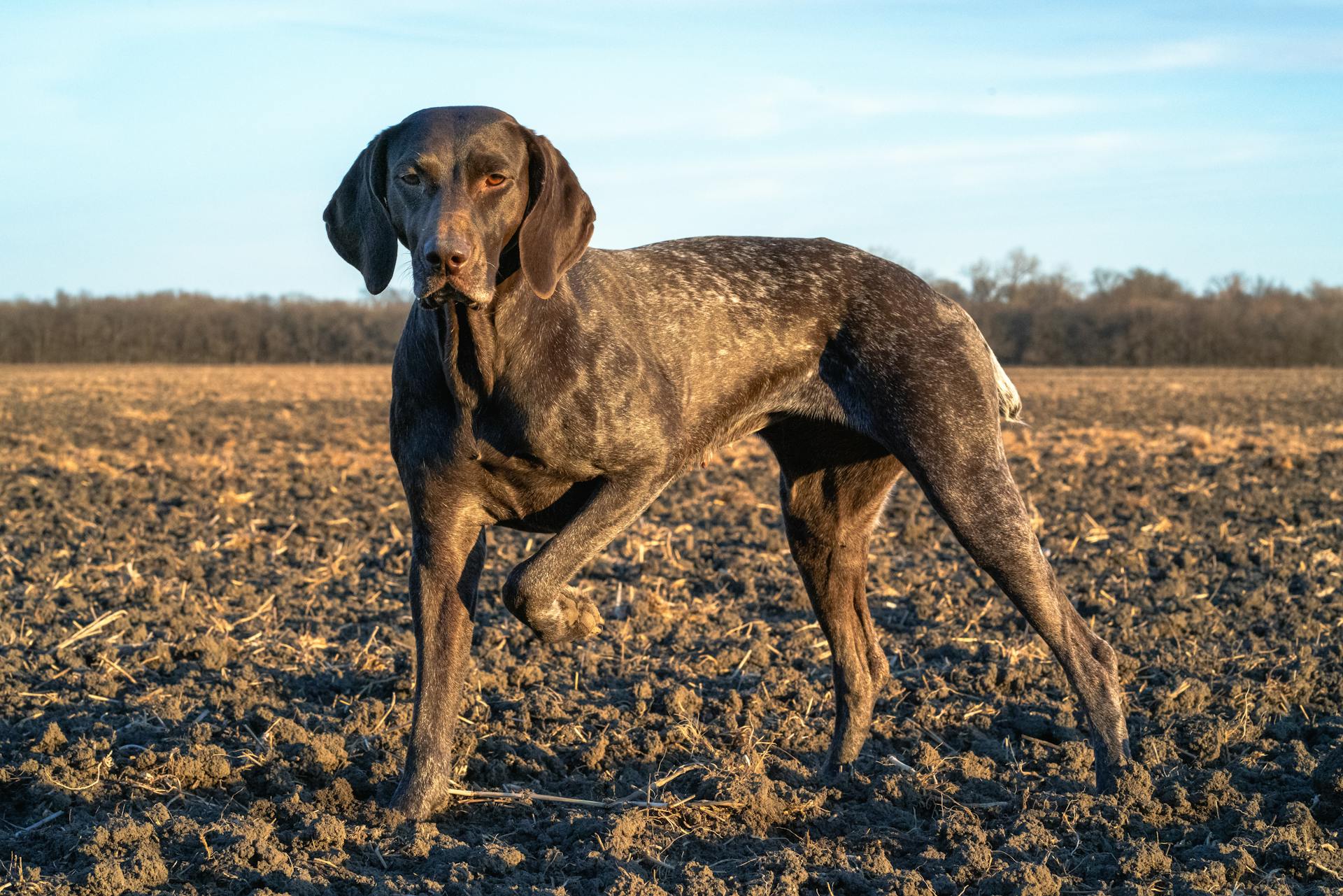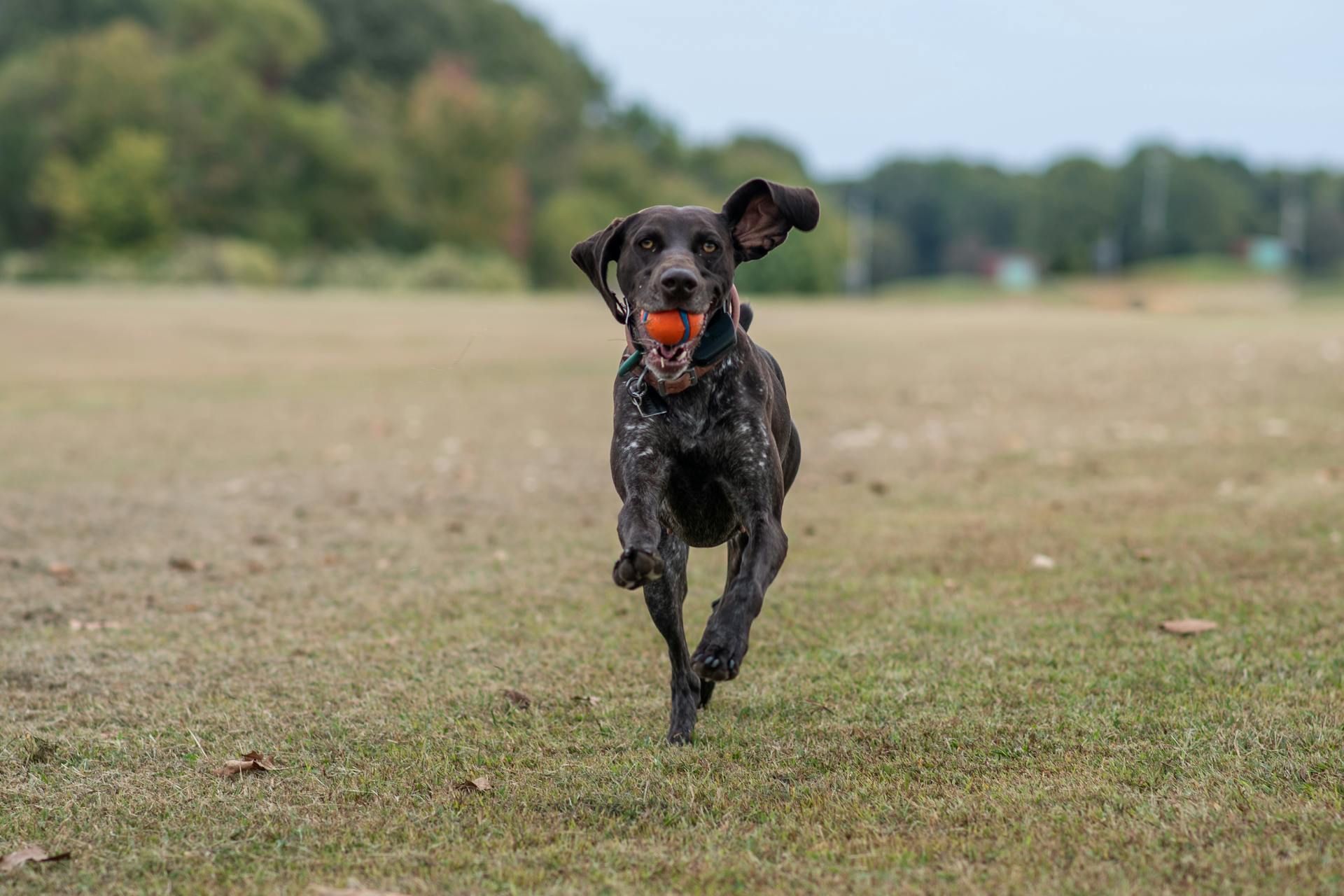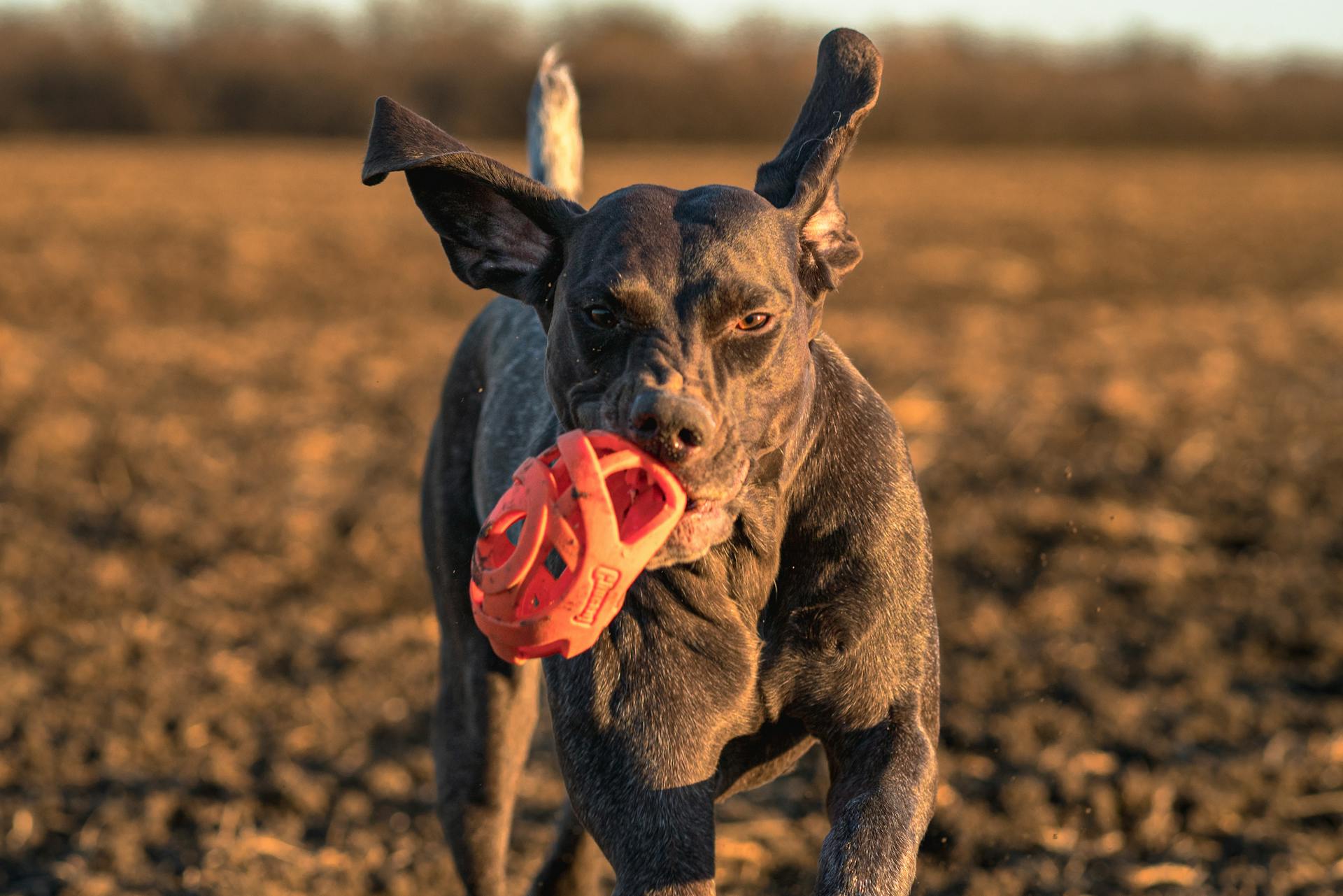
To keep your German Shorthaired Pointer happy and healthy, a well-balanced diet is essential.
Their energy needs are high, so they require a nutrient-rich food that's high in protein and fat.
A mix of commercial dog food and fresh fruits and vegetables can provide the necessary nutrients for optimal health.
They need at least 18% protein from animal sources, which can be found in foods like chicken, beef, and fish.
For your interest: Food for Dogs with High Blood Pressure
Diet Basics
German Shorthaired Pointers require a diet high in protein to support muscle maintenance and repair.
They need adequate fat for energy and essential fatty acids, along with carbohydrates for quick energy, and fiber for digestive health.
A nutritious diet is essential for your GSP, and the food they eat will change as they grow from puppy to adult, and then senior.
To keep those extra, unwanted pounds off your dog, measure out the food for each of their meals.
You should talk with your veterinarian if you are unsure about your dog's diet or exercise plan or would like better clarification on what a healthy weight looks like for your pup.
Feeding Strategies
Scheduled meals are generally recommended for German Shorthaired Pointers to prevent overeating and weight gain.
Fixed feeding times help with digestion and can prevent food aggression by setting clear boundaries. This is especially important for GSPs, as they can easily become overweight if overfed.
A recommended daily amount for a German Shorthaired Pointer is 2 to 3 cups of high-quality dry food, divided into two meals.
The quality of the dog food you choose also plays a role in nourishing your GSP, with higher-quality food providing better nutrition.
To maintain your GSP in good shape, it's recommended to measure their food and offer it in two meals per day rather than free-feeding throughout the day.
You can calculate your GSP's daily food portion based on their weight and activity level. For example, an average adult GSP weighs between 45 to 70 pounds and might require anywhere from 1,500 to 2,200 calories per day.
For your interest: How Many Treats Can a Dog Have a Day
Here's a general guide to daily food portions based on a dog's weight:
Puppies, adult dogs, and senior dogs all have different caloric needs, so it's essential to tailor your GSP's diet to their age and activity level.
Special Diets
For German Shorthaired Pointers, a high-protein diet is essential for maintaining lean muscle mass.
German Shorthaired Pointers are prone to obesity, so it's crucial to monitor their food intake and ensure they get plenty of exercise.
A balanced diet should include 25-30% protein, 45-50% fat, and 20-25% carbohydrates.
Their energy needs are high, so they require 2-3 cups of food per 10 pounds of body weight daily.
Their sensitive stomachs can be easily upset by spicy or fatty foods, so it's best to stick to a bland diet.
German Shorthaired Pointers can thrive on a raw diet, but it's essential to ensure they get all the necessary nutrients.
Their dietary needs change with age, so it's essential to adjust their food intake accordingly.
A German Shorthaired Pointer's diet should be tailored to their individual needs, taking into account factors such as age, health, and activity level.
Readers also liked: High Fat Food for Dogs
Feeding Methods
Scheduled meals are generally recommended for German Shorthaired Pointers, as free feeding can lead to overeating and weight gain.
Fixed feeding times help with digestion and can prevent food aggression by setting clear boundaries.
By establishing a regular meal schedule, you can help your German Shorthaired Pointer develop healthy eating habits and a strong bond with you.
For another approach, see: German Shorthaired Pointer Feeding Chart
Incorporating Wet Food into Your Dog's Diet
Incorporating wet food into your dog's diet can provide additional hydration and may be more palatable for some dogs. It's especially beneficial for older dogs or those with dental issues.
Dry food is great for dental health, but adding wet food can offer a nice change of pace for your dog's taste buds. A highly active GSP will naturally require more food compared to a less active couch potato dog, so consider their activity level when deciding how much wet food to add.
If you're unsure about how to incorporate wet food, start by adding a small amount to their meals and see how they react. You can mix it with their dry food or feed it separately, depending on their preference.
Worth a look: Wet Pomeranian Dog
Higher-quality dog food provides better nutrition, allowing you to feed smaller portions while meeting their nutritional requirements. This is especially important for GSPs, as they can be prone to overeating if not monitored properly.
By incorporating wet food into your GSP's diet, you can help ensure they're getting the nutrients they need to stay healthy and happy.
Treats and Extras
Treats are a great way to bond with your dog and make training more enjoyable. However, it's essential to remember that treats should be included in your dog's overall caloric intake.
Treats should not exceed 10% of your dog's total daily calories to prevent obesity.
Consider reading: Types of Dog Treats
Breed-Specific Information
The German Shorthaired Pointer is a high-energy breed that requires a balanced diet to maintain its overall health.
As a medium to large-sized dog, German Shorthaired Pointers need to eat between 1.5 to 2.5 cups of food per day, divided into 2-3 meals.
Their diet should consist of high-quality protein sources, such as chicken and fish, which provide essential amino acids for muscle growth and maintenance.
Breed Overview

The German Shorthaired Pointer is a versatile breed that excels as a hunting dog and family companion. They possess a distinctive appearance with a short, dense coat that comes in solid liver or liver and white, often with patching, ticking, or roan patterns.
They are energetic and intelligent dogs that thrive on work and play, requiring a significant amount of exercise to channel their energy. One to two hours of physical activity per day is recommended.
Their broad, dropped ears are set high and lie flat against the head, adding to their regal appearance. They have a muscular build and webbed feet, making them natural water dogs.
Males tend to be more outgoing and display more assertive hunting instincts compared to females. They are generally not aggressive and form a special bond with children, although they may be a bit boisterous for younger ones.
The GSP dislikes being left alone for extended periods and may exhibit signs of anxiety or engage in destructive behavior if deprived of regular companionship and exercise. They are eager to please their owners and respond well to praise, play, and food rewards.
See what others are reading: How Much Exercise Do Labrador Retrievers Need

They are capable of performing a wide range of gundog tasks, including pointing and retrieving, and are one of the few hunting breeds that can do it all. They are a stylish and versatile breed, combining exceptional hunting abilities with a friendly and affectionate nature.
German Shorthaired Pointers are suitable for active, experienced dog owners and families with older kids. They require close to two hours of moderate exercise every day and are not picky about how they receive it.
They can make great family dogs, getting along well with kids, but may be a little too rambunctious for young kids. It's essential to supervise all interactions between kids and the dog to ensure everyone's safety.
For another approach, see: Are Cocker Spaniels Good with Kids
How Big Do They Get?
So, you're wondering how big German Shorthaired Pointers get? They typically stand around 21-25 inches at their shoulder.
An average weight for German Shorthaired Pointers is 45-70 pounds.
Their size can vary, but the chance always exists that your GSP will be smaller or larger than these averages.
Health and Care
German Shorthaired Pointers are generally a healthy breed, but like all dogs, they are prone to certain health conditions. Hip dysplasia is a condition where the hip joint doesn't develop properly, and it's essential to get clearances from the Orthopedic Foundation for Animals (OFA) to ensure the parents have been tested and cleared.
Cancer is also a concern for GSPs, with a higher incidence of certain cancers such as mammary tumors, mast cell tumors, and lymphosarcoma. Regular vet check-ups can help detect any potential issues early on.
Gastric Dilatation-Volvulus (GDV), also known as Bloat or Torsion, is a life-threatening condition that can occur in deep-chested breeds like GSPs. Factors such as eating one large meal a day, eating rapidly, and exercising vigorously can contribute to GDV.
To keep your GSP healthy, it's crucial to provide a nutritious diet that meets their high protein needs. German Shorthaired Pointers require a diet rich in protein to support muscle maintenance and repair.
Exercise is also essential for GSPs, with about two hours of daily physical exercise recommended. Regular exercise can help prevent conditions like obesity and GDV.
Choosing the Right Food
Choosing the right food for your German Shorthaired Pointer is crucial for their overall health and well-being. The good news is that GSPs are relatively uncomplicated in their diet and can tolerate both dry and wet food.
A high-quality food with balanced ingredients is essential, especially for puppies and young dogs. This can help prevent postural problems and pain when moving.
Puppies and young dogs tend to grow too quickly if they're fed the wrong food, so it's essential to choose a food that supports natural growth. Overfeeding can lead to a range of issues, so be sure to follow the manufacturer's recommendations for the amount of food.
Adult GSPs have high energy consumption, so their food can be more substantial. If they get regular exercise, they'll be less likely to put on fat.
Premium foods often have higher-quality ingredients and more calories per cup, which means you might need to feed less volume compared to budget foods. This can be a great option if you're looking to simplify your dog's diet.
Take a look at this: Why Are Labrador Retrievers so Popular
General Information
The German Shorthaired Pointer diet is an essential aspect of their overall health and well-being. They require a balanced diet that meets their high energy needs.
To achieve this, you should feed your German Shorthaired Pointer 1.5 to 2 cups of high-quality dog food per 10 pounds of body weight daily. This can be divided into 2-3 meals, with some owners opting for a raw diet.
Their diet should include a mix of protein sources, such as chicken, beef, and fish, as well as complex carbohydrates and healthy fats.
Origin and History
The German Shorthaired Pointer has a rich history dating back to the 17th century, with the breed we know today emerging in the mid- to late 19th century.
The early predecessors of the GSP were known as German Pointers or German Bird Dogs, resulting from crosses between Spanish Pointers and Bloodhounds. These crosses produced a large hound-like dog with a keen sense of smell.

Hunters sought dogs with obedient personalities, but they also desired style and elegance to accompany their scenting abilities. To add style, Pointers from England were introduced, creating a dog that excelled both on land and in water.
Prince Albrecht zu Solms-Braunfeld of the Royal House of Hanover played a significant role in encouraging breeders to prioritize function over form when selecting early specimens. As a result, a lean, athletic, and responsive hunting dog emerged, showcasing intelligence and affection as a companion.
The first German Shorthair arrived in the United States in 1925, imported by Dr. Charles Thornton of Montana, who went on to breed them. Merely five years later, the breed gained recognition from the American Kennel Club (AKC), with Greif v.d. Fliegerhalde being the first registered German Shorthair with the AKC.
The German Shorthaired Pointer is descended from the Old German Shorthaired Pointing Dog, which originated from the crossbreeding of Bracco Italiano and Bloodhounds. Later, other breeds, such as the English pointer, were also crossed in.
In the 19th century, many crosses were made to breed new hunting dog breeds, including the Deutsch Kurzhaar breed, which was created in 1879. The robustness of the breed was defined as the most important characteristic at that time.
Suggestion: Old Style German Shepherd Dogs

The German Shorthaired Pointer first appeared in the United States in the 1920s, imported by Dr. Charles Thornton, a resident of Montana. The breed gained significant recognition throughout the States in just a handful of years.
Today, the German Shorthaired Pointer holds the 19th position among the 155 breeds and varieties recognized by the AKC, reflecting its popularity and standing among dog enthusiasts.
Characteristics
The German Shorthaired Pointer is a versatile hunting dog that originated in Germany. It belongs to group 7, the pointing dogs, recognized by the FCI.
Its coat can have different colors, ranging from a solid light brown to dark shades of black, and some dogs have a white base color with brown or black patches. Hard, rough guard hairs grow over the dense undercoat.
The German Shorthaired Pointer is a born hunter with a strong urge to move, and it needs daily exercise to prevent restlessness. It's also very quick to show training success, making it a great breed for experienced dog handlers.

This breed is hardly afraid of water and loves to jump into ditches or lakes, making it perfect for outdoor activities. Its innate pointing behavior allows it to follow the scent of game without distraction.
The German Shorthaired Pointer is not suitable for kennel keeping and thrives on a bond with its owner. It's calm and even-tempered, but requires consistent and sensitive guidance when walking on a lead.
Overview
The German Shorthaired Pointer is a versatile and elegant sporting breed that excels both as a hunting dog and a loving family companion.
He's slightly smaller than a Pointer, with a distinctive and regal appearance, featuring a chiseled head, dark almond-shaped eyes, and a large, dark nose.
His broad, dropped ears are set high and lie flat against the head, while his short, dense, and sleek coat comes in solid liver or liver and white, often with patching, ticking, or roan patterns.

The breed's tail is typically docked, leaving about 40 percent of its original length.
The German Shorthaired Pointer is an energetic and intelligent dog that thrives on both work and play, cherishing human companionship and forming a special bond with children.
However, he may be a bit boisterous for younger ones, and dislikes being left alone for extended periods, which can lead to anxiety or destructive behavior.
Males tend to be more outgoing and display more assertive hunting instincts compared to females.
The muscular GSP requires a significant amount of exercise to channel his energy, with at least one to two hours of physical activity each day.
With his webbed feet and water-resistant coat, he particularly enjoys swimming and is a natural water dog, making him a great companion for pool owners.
Quick Facts
The German Shorthaired Pointer is a versatile breed that's perfect for active families. Originating from Germany, this Sporting breed is bred for hunting and excels in agility and obedience training.

Here are some quick facts about the German Shorthaired Pointer:
- Height: 22-25 inches (male), 21-23 inches (female)
- Weight: 55-70 pounds (male), 45-60 pounds (female)
- Lifespan: 12-14 years
- Grooming needs: Moderate
- Exercise requirements: High
- Training: Relatively easy to train, but can be stubborn at times
This breed is known for its friendly, intelligent, and eager-to-please temperament, making it a great companion for many families. With proper care and attention, a German Shorthaired Pointer can thrive and become a beloved member of the family.
Frequently Asked Questions
Do German Shorthaired Pointers eat a lot?
German Shorthaired Pointers have a high energy requirement and typically eat 2-5 cups of food per day, depending on their activity level and metabolism. They require a diet rich in fat and protein to support their active lifestyle.
How many times a day should I feed my German Shorthaired Pointer?
Feed your German Shorthaired Pointer 2-3 times a day, adjusting to twice a day once they reach adulthood
Sources
- https://iheartdogs.com/how-much-do-you-feed-a-german-shorthaired-pointer/
- https://dogtime.com/dog-breeds/german-shorthaired-pointer
- https://www.dogster.com/dog-breeds/german-shorthaired-pointer
- https://www.aspcapetinsurance.com/resources/german-shorthaired-pointer/
- https://www.hundeo.com/en/dog-breeds/german-shorthaired-pointer/
Featured Images: pexels.com


